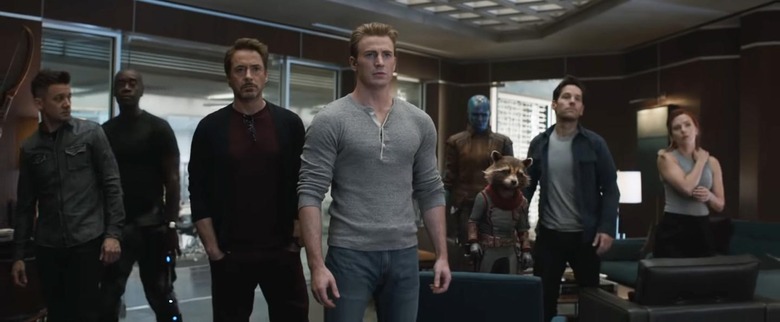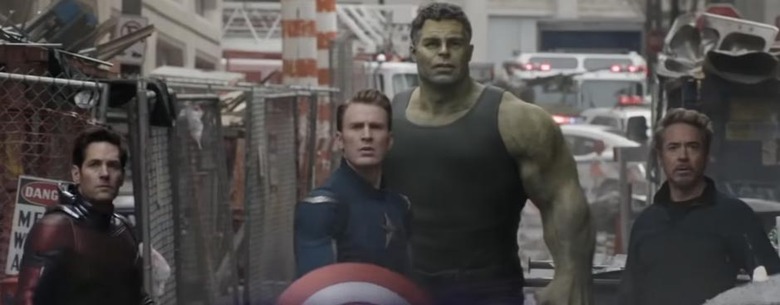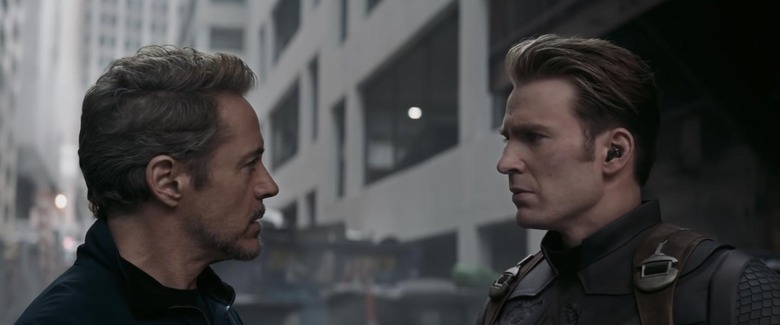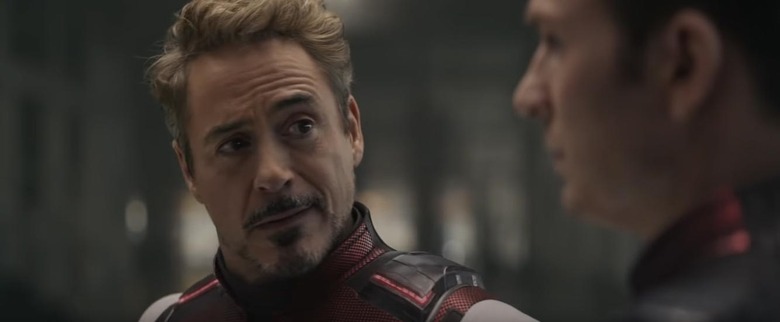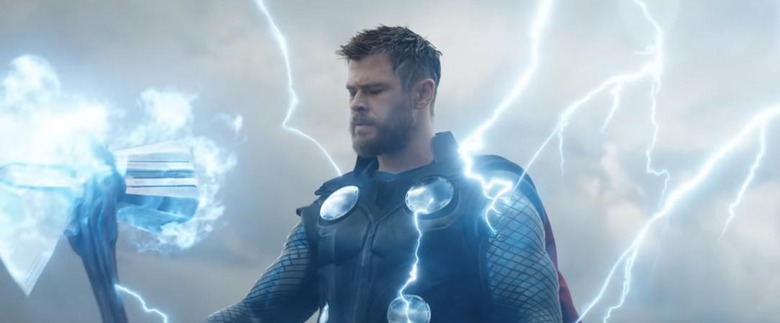Road To Endgame: 'Avengers: Endgame' Is A Bold New Beginning (And Look Back) For The Marvel Cinematic Universe
(Welcome to Road to Endgame, where we revisit the first 22 movies of the Marvel Cinematic Universe and ask, "How did we get here?" In part 1 of our look at Avengers: Endgame: how the film sets up its breathtaking finale.)It's never too late for course-correction.As Marvel has steamrolled its way through popular culture, its failings seem to matter less and less. For every middling entry like Thor: The Dark World, there's a riotous follow-up like Thor: Ragnarok, which lampshades its series' tropes, remixes its themes and kills-off existing characters it doesn't know what to do with, effectively removing the former from canon. To borrow the parlance of sister-franchise Star Wars, "Let the past die. Kill it if you have to." Though, what Star Wars: The Last Jedi understood about this approach (spoken and acted upon by the villain Kylo Ren) was, ironically, something Ragnarok understood as well, despite sweeping its predecessor under the rug: that failure undealt with can come back to haunt you, and that real growth and catharsis means learning from the past before moving on.Spoilers for Avengers: Endgame begin here.The Avengers are shackled by the past. The horrors they've seen, those they've failed to prevent, and even those they've committed themselves. Weeks after the events of Avengers: Infinity War, they search desperately for a way to undo Thanos' devastation — a universal genocide, wiping out half of all life — but they come up short on their quest. In what plays like Infinity War's missing third act, the remaining heroes track down the Mad Titan only to discover that the Infinity Stones, which could have been used to bring back their fallen comrades, are no more. Thor, in his anger over failing to stop Thanos before, beheads him without mercy, effectively ending the story.The real story begins five years later, as the characters finally deal with the consequences of their failures. What follows is a film that veers between both the quiet contemplations and raucous eruptions that have been missing from these films for far too long. The result is often messy, imbalanced and bloated, but it's ultimately satisfying despite all these things, because it picks up the broken pieces of a decade-long series without running from what came before.This is Avengers: Endgame.
Re-Introducing the Avengers
A full hour goes by before a major fight scene — both a welcome reprieve and a surprising one — because Avengers: Endgame is as concerned with winking fan-service as it is with paying off a decade of story. Fittingly, those two things end up being one and the same on more than one occasion. The way some characters' stories conclude is far from ideal, but before all the fun and fireworks, each original Avenger gets their moment to shine, as the film paints them as a product of their failures.Black Widow/Natasha Romanoff now leads the Avengers, or what's left of them. She checks-in constantly, keeping a track of both earth-bound issues and problems out in space, and she even asks de-facto Wakandan leader Okoye what they can do to stop natural disasters. She's thrown herself into her work out of desperation, in the hopes of finding some way to make up for letting half her people die. She's still trying to wipe the red from her ledger, as it were, though despite now having Tony Stark's obsessive disposition, she lacks the tools and the know-how to take radical steps.Captain America/Steve Rogers, too, has taken on the mantle of a fellow Avenger: The Falcon/Sam Wilson who, in Captain America: The Winter Soldier, was introduced as a counselor for returning veterans. Rogers now leads group therapy sessions out in New Jersey, where he helps grief-stricken citizens move on from the global devastation. Though his optimism is hardly practical. Rogers seemingly having moved on (or having pretended to) is grating to the likes of Romanoff, who can't bring herself to do the same. Despite his talk of now seeing whales in the Hudson, this isn't what moving on from loss really looks like for Rogers — as evidenced later in the film, when he ventures back to his "birthplace," Camp Lehigh. It's just what burying his grief and giving up looks like, since there's nothing left for him to avenge.Tony Stark/Iron Man has given up too, though for him, burying the past means opting for a selfish future. A respite he's more than earned, given his work since 2008 — he chooses his wife and daughter over helping the world — but at the same time, it's the ultimate signifier of his failure. In all his appearances between Iron Man and Avengers: Age of Ultron, the series seemed to push the reset button on Stark, though this narrative stagnancy eventually became the character's cornerstone, as he tinkered with newer, more dangerous ways to protect the world at large, even at the cost of his relationships. Now, he has everything he could want in his personal life, though it comes at the cost of the greater good. In a way, it had to; Tony Stark could never have had it all when the world was still in danger.Clint Barton/Hawkeye, after proving to be the beating heart of the team in Avengers: Age of Ultron, has become a ruthless vigilante. A man who once fought for his wife, his kids, and his protégé Wanda Maximoff, he's had them ripped away. Now he fights out of pure, blinding, nihilistic rage, killing the organized criminals who Thanos spared — as if to step into Thanos' shoes, enacting a twisted vision of universal balance (albeit solely on people of colour, as far as we see; a bizarre choice of optics). When Romanoff tells him there might be a way out, the mere thought of hope feels like despair.Thor, despite the camera's occasional fat-shaming gaze, feels appropriately tragic, having lost himself down a rabbit-hole of food and drink. He looks more like his comrade Volstagg (Ray Stevenson) than the God of Thunder, though what brings this new Thor to life is Chris Hemsworth's devastating performance, as a man burying his sorrows beneath everything from facial hair to video games. When the camera isn't focused on Thor's prosthetic gut for cheap laughs (in contrast, Tony Stark's weight-loss is treated with the requisite seriousness), Hemsworth's eyes betray the sorrow behind his playful smile. Every one of his films thus far was about living up to his father's expectations of great leadership. But now, he's left even "New Asgard" to its own devices, as the mere mention of Thanos fills him with crippling dread.Five out of six ain't bad, right?
Re-Introducing the Rest
Bruce Banner/The Hulk is delightful in his hybrid form, but what separates him from his teammates is he doesn't feel like a product of a world where half the people have been snapped away; it's as if he's been pulled from some other, earlier Marvel film, like a leftover concept. He even references feeling lost and then finding a sense of balance — the biggest possible development for this character takes place off screen! — and after his dropped character arc in Avengers: Infinity War, his re-introduction here serves little purpose beyond comic relief.Still, the subversion of the Hulk now being the cheeriest and most put-together of the bunch is pleasant enough to not be a major detraction, especially when compared to the otherwise happy-go-lucky Scott Lang/Ant-Man. Lang, after returning to a world where his friends have suddenly been dead for five years, is filled with a sense of inexplicable angst, as he tries to process what Hope Van Dyne/The Wasp actually meant to him. His point-of-view becomes vital to understanding this dour new world, a realization that allows Paul Rudd to imbue the character with more urgency, and a shorter temper.Of the remaining characters, Nebula finds herself in the most interesting position, at least in initial scenes. Once a ruthless assassin who paid back the pain she was dealt, she's now a caregiver to the likes of Tony Stark, who appears to be living his final days as the two are stranded in space, and to Rocket, with whom she commiserates over the Guardians' deaths when she arrives on Earth. Though once the plot kicks into motion and jumps ahead five years, she and Rocket are essentially out of the picture, protecting distant quadrants until it's time for the team to re-unite. Not every character can be handled with deftness in a film so large, but it's still a disappointment given the way this same team of creators — directors Joe & Anthony Russo, and writers Christopher Markus and Stephen McFeely — were able to give nearly a dozen characters coherent story arcs in Captain America: Civil War.Okoye ends up sidelined too, despite having one of the most powerful reactions to any death in Avengers: Infinity War. Carol Danvers, who's barely had a chance to interact with the main characters, even announces her departure from the film early on, so the increased focus she's given in the film's climax makes little sense, given how flimsy of a connection she has to the people and events on-screen. Rhodey/War Machine, too, ends up in the middle ground as usual, forever a supporting player to the other heroes.While the supporting cast members often feel like benched players, the remaining Avengers' arcs do, for the most part, pay off the stories the set up by the film's first hour. And the result, while nestled amidst the usual bombast, is marvelous.
Revisiting the Past: Iron Man and Captain America
After Lang returns from his quantum trip — five hours later for him, five years later for the rest — the Avengers decide to venture into the past and retrieve the Infinity Stones before they're destroyed. The film establishes its time-travel rules up front (though it breaks them for good dramatic reason in the final scene), in that changing the past won't change the present, but would create alternate timelines instead. This allows for greater dramatic and even comedic possibilities amidst the Avengers' scheme, since interacting with the past isn't off the table. Of course, since they aren't racing against a ticking clock, they're also in possession of a very limited supply of Hank Pym's science mumbo jumbo juice, the Pym Particles, so do-overs are nearly impossible.This "time heist" is the indulgent payoff to eleven years of shared continuity. Avengers: Endgame is separated from most time-travel films because the characters re-visit not only past events, but entirely different movies, and the choice of when and where they visit is especially dramatically potent.The team of Banner, Stark, Rogers and Lang all land up in New York during The Avengers, wherein the film tools around with its predecessor's visual language ever so slightly. We first re-visit the iconic shot of the original team assembling for the very first time. However, the camera holds about a second longer, as they begin to leave their circular formation; right from the get-go, we witness events as they already occurred, though from a slightly altered perspective (and with foreknowledge of how they played out, given what our time-travelers know).In what amounts to the unseen post-script of the "Battle of New York," the time-travelling quartet inserts themselves into the gaps between familiar scenes and characters. Rogers even battles a past version of himself, jokingly dismissing his own "I can do this all day" catchphrase, before sullying the past Rogers' view of reality ("Bucky is alive!") in order to distract him. The present Rogers meets his past self at arguably his most saccharine, before his worldview was thrown for a loop in Captain America: The Winter Soldier and before he'd wised up to the complexities modern world.In essence, the current Steve Rogers, who uses unbridled, uncritical optimism as a crutch, is forced to take advantage of his own naïveté — his first step to accepting that he hasn't actually moved on, or really dealt with the bleakness of the modern world. His second step occurs when he and Stark are forced to travel back further, after an unexpected kerfuffle involving Loki and the Tesseract, wherein both men are faced with the spectres of their pasts (while Banner is off providing alternate-dimension exposition with The Ancient One, presumably to set up future films and shows).
Camp Lehigh
In the 1970s, in order to retrieve both extra Pym Particles an earlier version of the Tesseract from S.H.I.E.L.D., Stark and Rogers venture to Camp Lehigh — "The Birthplace of Captain America," previously seen in The First Avenger and The Winter Soldier — where Stark, like a mischievous child, has to talk his way out of being found out by his own father, Howard. Meanwhile, Rogers hides out in Peggy Carter's office where he sees his picture on her desk, decades after his disappearance. Here, he catches a glimpse of the woman and the life he thought he'd had no choice but to leave behind — "Family. Stability. The guy who wanted all that went into the ice 75 years ago," he says in Avengers: Age of Ultron.Stark, a father himself, has begun healing from his paternal abandonment in the five years since the snap, as he now that he understands the position his own father was in. He even gives expecting parent Howard fatherly advice of his own, as if to close the loop that was opened (and subsequently dropped) by Iron Man 2, arguably one of the worst films in the series. As if to echo the events of Iron Man 2, in which Stark invents a new element thanks to his father's secret messages, time-travel becomes a possibility when Stark makes a similar discovery via computer simulation. Only this time, rather than the result of phantom daddy issues that don't quite manifest, this discovery leads him to confronting his father and finding closure. And, in a more immediate sense, it also has real and tangible dramatic grounding.Where the "new element" was a means to create a new suit, Stark's time-travel "Eureka!" moment leads to a moral dilemma, one that forces him to choose between his own family and stability, and the greater good that might put them at risk. As if to confirm that Tony Stark made the right choice, the young Howard Stark elucidates his own major character flaw — "Let's just say the greater good has rarely outweighed my own self-interest" — as something he hopes his son will someday learn from. Of course, unbeknownst to him, Tony Stark is living proof that Howard left the world better than he found it, as the series finally makes good on the line of dialogue that Howard, in his own form of time travel, would go on to record on film and leave to his son:"What is and always will be my greatest creation, is you."
Revisiting The Past: Thor
In a similar instance of re-visiting a generally disliked film, Thor and Rocket attempt to extract the Reality Stone from a sleeping Jane Foster during the events of Thor: The Dark World. A major failing of Thor's first sequel (and of the MCU in general) is how often characters' mothers are brushed aside in favour of deeply rooted paternal angst. In The Dark World, Thor's mother Frigga dies in battle, and neither of her sons are afforded much of a reaction in the edit, let alone a long-lasting grief that defines their actions or stories. Her death felt incidental, though here, it's finally given greater importance when Thor returns to the day she's destined to die.The purpose of fathers in the Marvel Universe is heroes wrestling with legacy. The Wakandan legacy, the Stark legacy, the Asgardian legacy, the list goes on. Thor, thus far, has been defined by how he chooses to rule Asgard. This mantle and responsibility is passed down to him by his father, Odin, whose approval he spends three films fighting for in some way. Yet it takes Frigga's nurturing to free Thor from this cycle of failing to live up to his father's kingship.The anxiety-stricken Thor is visibly lost; "The future has not been kind to you," Frigga tells him, recognizing his ruse. Rather than telling how to live up to lofty expectations (set for him over the centuries!), she advises him on how to deal with his failures: by succeeding at being who he is, rather than who he's "supposed to be." It's a touching sentiment, and while there's little follow-through to be found in Endgame itself (though it motivates him in the moment, pushing him to retrieve his hammer and prove his worth), it does allow his story to end on a meaningful, coming-of-age note, as he ventures off to find himself alongside the Guardians.Unlike The Avengers, few of these story threads individually manifest in the climactic fight, as one might now expect from Marvel. Though Endgame's final battle, in its totality, is still built on these individual stories. Despite its various failings, the scene proves to be one of the very best in the Marvel Universe, offering payoff upon payoff in one of the most rousing cinematic climaxes in recent memory.
***
In Part 2: the final battle, the women of Marvel, and why the film's fan-service (mostly) works.

